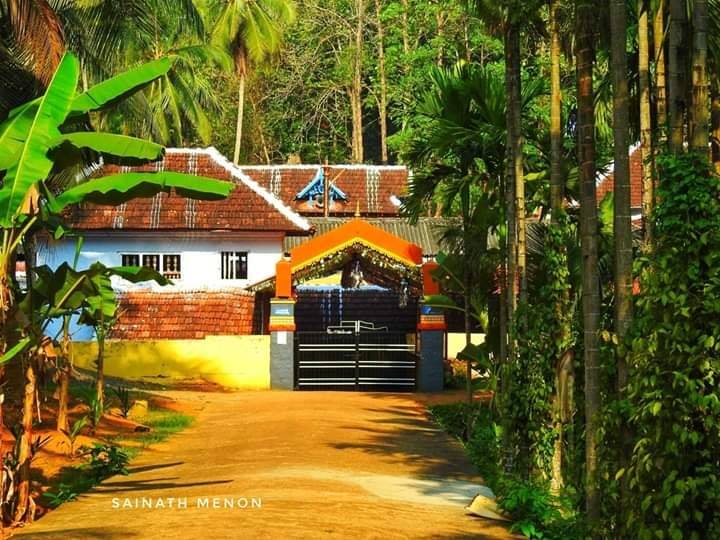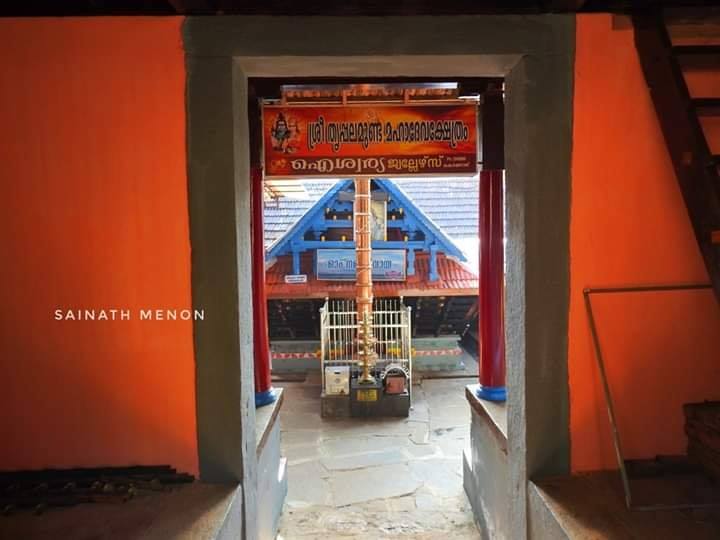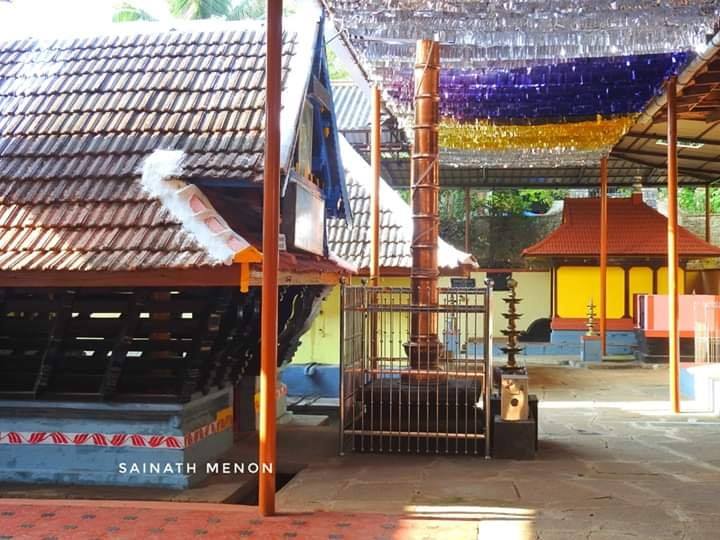Thrippalamunda Mahadeva Temple is located in the beautiful village of Thrippalamunda, in Kongad Panchayat of Palakkad district.

The presiding deity here is Lord Parameswara (Lord Shiva) along with Goddess Parvathy, and the idol is believed to be self-manifested (Swayambhu). The deity faces west and is enshrined in a copper-clad sanctum sanctorum (Sreekovil), which also holds the sacred Ganga Teertha.
Sub-deities (Upa Devatas) at the temple include Lord Ganapathy, Lord Ayyappa, the Navagrahas (nine planets), and serpent deities (Naga Devatas), while Nandikeswara is positioned at the Mukha Mandapam (entrance hall).
Currently, the temple is managed under the Malabar Devaswom Board, overseen by a Trustee Board.According to legend, long ago, a woman went to graze cattle in the fields surrounding the temple. As she sharpened her sickle on a stone, blood began to flow from it. Shocked, she spat on the stone, and a celestial voice (Asareeri) proclaimed, "This is not just any stone; it is Mundem!" (meaning 'sacred'). Terrified, she fled, and the area where she spat came to be known as "Mundem," which later evolved into "Thrippalamunda."
Realizing the divine presence in the bleeding stone, the locals established a temple at that very spot.
Even today, the temple stands in the same paddy fields, preserving this ancient legend. Inside the sanctum, there is a constant presence of water, similar to that found in a wet field. A small, sacred well, known as "Manikinar," is situated at the northeast corner (Kannimoola) of the Sreekovil, and it never dries up. Water drawn from this well is used for all ritualistic purposes, including for preparing offerings (Nivedyam).
Additionally, outside the Nalambalam (inner courtyard), a stream called "Theertha Chaal" flows continuously throughout the year. The temple premises also feature three ponds — the Theertha Kulam to the south, the Palakkulam to the east, and big pond to the north. Each serves a different purpose: the Theertha Kulam for the temple's sacred needs, the Palakkulam for the use of the Thantris (temple priests), and the Valiya Kulam for the general public.
Thus, the temple stands majestically amidst a landscape blessed with abundant water, centered around the worship of the mighty Mahadeva.
Annual festival begins with the hoisting of the temple flag (Kodiyettam) on the sixth day of the Malayalam month of Kumbham (February–March), marking Maha Shivaratri. The celebrations include Pallivetta (symbolic royal hunt) and conclude with the grand Aarattu (holy bath ritual).
തൃപ്പലമുണ്ട മഹാദേവ ക്ഷേത്രം
പാലക്കാട് ജില്ലയിലെ കോങ്ങാട് പഞ്ചായത്തിലെ തൃപ്പലമുണ്ട എന്ന മനോഹരമായ ഗ്രാമത്തിലാണ് തൃപ്പലമുണ്ട മഹാദേവ ക്ഷേത്രം സ്ഥിതി ചെയ്യുന്നത്. സ്വയംഭുവായ, പാർവ്വതിസമേതനായ പരമശിവനാണ് ഇവിടെ പ്രതിഷ്ഠ. ചെമ്പ് പൊതിഞ്ഞ ശ്രീകോവിലിൽ പടിഞ്ഞാറ് മുഖമായി ഭഗവാൻ വാസം കഴിച്ചിരിക്കുന്നു.
ഉപദേവന്മാരായി ഗണപതി, അയ്യപ്പസ്വാമി, നവഗ്രഹങ്ങൾ, നാഗദേവതകൾ എന്നിവയും, മുഖമണ്ഡപത്തിൽ നന്ദികേശ്വരനും ക്ഷേത്രത്തിൽ വാസം ചെയ്യുന്നു. ഇപ്പോൾ മലബാർ ദേവസ്വത്തിന്റെ കീഴിലായ ക്ഷേത്രം ട്രസ്റ്റി ബോർഡിന്റെ നിയന്ത്രണത്തിലാണ് പ്രവർത്തിക്കുന്നത്.നാലുഭാഗവും കുന്നുകൾ കൊണ്ട് ചുറ്റപ്പെട്ട പാടത്താണ് ക്ഷേത്രം സ്ഥിതി ചെയ്യുന്നത്.
ഐതിഹ്യമനുസരിച്ച്, ഒരു സ്ത്രീ ഈ പാടത്ത് പുല്ലറിക്കാൻ വന്നപ്പോൾ, കയ്യിലുള്ള അരിവാൾ കല്ലിൽ ഉരച്ചപ്പോഴാണ് കല്ലിൽ നിന്ന് ചോര ഒഴുകിയത്. അതിന്റെ ഭയത്തിൽ സ്ത്രീ തുപ്പിയപ്പോൾ, ആ കല്ലിൽ നിന്ന് "തുപ്പല്ലമുണ്ടെ" എന്ന ശബ്ദം (അശരീരി) ഉദിച്ചുവെന്നാണ് പറയപ്പെടുന്നത്. പിന്നീട് ആ സ്ഥലത്തിന് 'തൃപ്പലമുണ്ട്' എന്ന പേരായതാണെന്നും, ശിവചൈതന്യം തിരിച്ചറിഞ്ഞു ക്ഷേത്രം സ്ഥാപിച്ചെന്നും വിശ്വാസമുണ്ട്. ഇന്നും പാടത്തെയാണ് ക്ഷേത്രം നിലകൊള്ളുന്നത്. ശ്രീകോവിലിനുള്ളിലും ജലസാന്നിധ്യം കാണാം.
കന്നിമൂലയിൽ, ഏതുകാലത്തും വെള്ളം വറ്റാതെ കൈകൊണ്ട് വെള്ളം കോരാവുന്ന മണിക്കിണർ ഉണ്ട്. നൈവേദ്യത്തിനുള്ള വെള്ളവും ഇവിടുമുതലാണ് കോരുന്നത്. തീർത്ഥകുളം അഗ്രശാലയുടെ ആവശ്യങ്ങൾക്കായി, പാലക്കുളം തന്ത്രിമാർക്കായി, വലിയകുളം പൊതുജനങ്ങൾക്കായി ഉപയോഗിക്കുന്നു. കുംഭമാസത്തിലെ ശിവരാത്രി മഹോത്സവം ആറാം ദിവസമാണ് കൊടിയേറ്റത്തോടെ ആരംഭിക്കുന്നത്. തുടർന്ന് പള്ളിവേട്ടയും, ആറാട്ട് ചടങ്ങുകളും ഭക്തിപൂർവം നടന്നു വരുന്നു.



